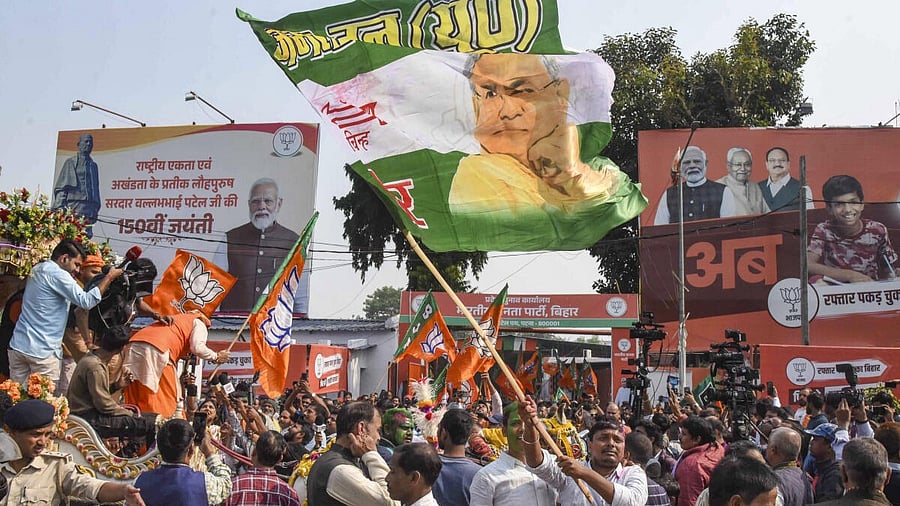
NDA supporters celebrate the alliance's victory in Patna.
Credit: PTI Photo
The Bihar mandate is for status quo, not change, generational or otherwise. It is for the same coalition, same set of leaders, chief minister, and continuation of similar policies and governance model. Save a few new faces and some missing ones, there will be no other evidence of a new order.
The results are also a negative vote mandate against the I.N.D.I.A. bloc, or the Mahagathbandhan (MGB), as it is called in Bihar.
Effectively, the decision of the people of Bihar to hand out an overwhelming mandate to the National Democratic Alliance (NDA), mirrors their despondency or the absence of a replacement — it is the TINA Factor (There Is No Alternative) once again.
Unless the Bharatiya Janata Party (BJP) opts for hara-kiri right away, Nitish Kumar will remain chief minister, with maybe a few more ministers from other NDA allies. The vote is partially an endorsement for him.
Nitish Kumar may not be seen as a proactive saviour picking up cudgels to protect families that the state’s migrant labourers leave behind. But, he is certainly envisioned as a benign ‘uncle’ who will not allow the co-ordinated takeover of local power hubs by clansmen owing allegiance to the other dominant party, the Rashtriya Janata Dal (RJD).
The Tejashwi Yadav-led MGB carried the smear of ‘jungle raj’ and its leaders failed to convince voters that this accusation is now a thing of the past. The primary reason for this lies in the RJD’s failure to widen its social base from the Muslim-Yadav segment — a social coalition no longer adequate to win polls.
Paradoxically, despite its dismal tally, the RJD, still has the largest vote share (if trends at the point of writing this hold). Its vote share, this time too, is likely to be close to the 23.11% it polled in 2020.
Its largest alliance partner, the Congress’ vote share is likely to decline by barely 1%. Why then has their collective tally declined from 94 in 2020 to around 35 seats?
The NDA, under the BJP’s leadership, stitched a well-knit alliance with its leadership deciding to contest the same number of seats as the Janata Dal (United); not as many in the party expected, even wanted.
The BJP also secured its three other partners in firm pacts: the mid-sized Chirag Paswan-led Lok Janshakti Party (LJP) and the two minor allies, the Rashtriya Lok Morcha and the Hindustani Awam Morcha headed by Upendra Kushwaha and Jitan Ram Manjhi respectively. There were discords, like in all coalitions, but these were ironed out early.
In contrast, the MGB worked at cross-purposes, even fielding candidates against one another in some seats, calling it ‘friendly fights’.
Tejashwi Yadav was initially absent, and when he later joined the rallies, he appeared to be an unenthusiastic participant. The MGB’s smaller parties, including the Vikassheel Insaan Party, could not pull their weight.
The NDA’s electoral mathematics was bang on. The BJP’s campaign too was ably directed and backed by an organisational steel, assiduously rebuilt from 2014 onward.
Furthermore, Prime Minister Narendra Modi is driven by an insatiable drive for power and remains possibly India’s most self-punishing politician when it comes to being on the road and simultaneously managing the massive administrative framework, even while keeping a tab on the party organisation. Neither of the two principal challengers, Gandhi and Yadav, was a match.
There could not have been a better shot in the arm for Modi than this two-thirds-plus sweep. A failure to secure a majority in last year’s Lok Sabha elections is now well and truly in the past. After June 4, 2024, Modi was expected to be more accommodating and open to consensual ways.
Little changed for a variety of reasons, mainly because the three most numerically significant coalition partners, the Telugu Desam Party, the JD(U) and LJP, chose not to be as demanding as believed they would. Modi found ways to satiate them, and is likely to do so in Bihar, starting with retaining Nitish Kumar in the CMO, at least for now. The writ of one shall continue to prevail after this verdict.
Nilanjan Mukhopadhyay is a journalist and author of ‘Narendra Modi: The Man, The Times’ and ‘The RSS: Icons of the Indian Right’. X: @NilanjanUdwin
(Disclaimer: The views expressed above are the author's own. They do not necessarily reflect the views of DH.)